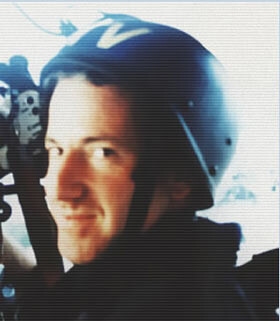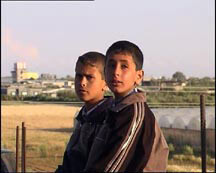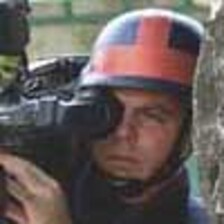The Electronic Intifada 1 July 2004

James Miller
Shah states from the outset that Death in Gaza “is not about the rights and wrongs of the Israel-Palestine conflict”. But it is. The film opens with the disturbing scene of the aftermath of an illegal extrajudicial assassination. Shah says, “Israel is defending itself against a wave of suicide bombers”, which is likely to irk anyone watching the unfolding scene of Palestinian children picking through bits of blood, skin and flesh on a sidewalk after a “targeted assassination” by Israeli agents. The children are helping the paramedics collect all they can in time for burial before sunset.
I saw the original version of this film in the Other Cinema just off Leicester Square in April 2004 before it was aired on Channel 4. The producers had cut one of the best scenes, of Palestinian children playing in Nablus, “where it is said that 80% of suicide bombings originate”, yet Shah says she only sees “children playing football in the streets”. Miller then captures a scene on camera of teenage boys in Nablus throwing stones at an Israeli tank, an armored personnel carrier (APC) and a truck.
James is more worried about the tanks than the stones.
The truck tries to reverse into Miller while he is filming. He manages to get out of the way before he is hit. The soldiers were firing live ammunition at the boys; most of the bullets ricochet off the concrete, and somehow no one got shot (at least not on camera). One of the boys captured on film is wearing a black hat with the word “USA”. Miller zooms in on the boy’s face which is filmed in slow motion. The boy could have been a kid from Brooklyn - if it was not for the fact that he was in Nablus - one would not know the difference. No wonder the scene was axed in the television version.
After Nablus, the crew set off for the Gaza Strip. However, the viewer isn’t shown just how difficult it is to get into Gaza, so one might assume that Israel and the occupied territories are all one contiguous territory where people can drive in and out with ease. There is no mention of the fence surrounding Gaza and no discussion of the Erez checkpoint and the industrial zone - providing jobs for 4,000 Palestinian labourers - which Ehud Olmert recently announced he would be closing down. Instead, the audience sees palm trees and the Mediterranean. It looks like paradise. That is until they get to Rafah.
It is in Rafah where the rest of the story unfolds around the lives of 3 children: Mohammed (12 years), Ahmed (12) and Najla (16). Ahmad is Mohammed’s best friend and they do everything together. Najla wants to be a lawyer and “give justice to the Palestinians”. Najla lost her home 3 weeks ago when it was bulldozed by the Israeli army during “Operation Rainbow”. Rafah is a border town full of refugees from 1948 and 1967 when they fled or were expelled from their homes which are now in what is called Israel. It is entirely probable that these refugees are being made homeless for the third or fourth time in their lives. This is not explained in the film.
On May 2, 2003, James spent his last day filming in Najla’s house near the Rafah border. Around 7:30 p.m., a bulldozer and an APC came near Najla’s house searching a nearby building for the resistance. The army has night vision equipment. At around 11:00 p.m., Shah and Miller decide to approach the APC holding a white flag and a flashlight with “TV” written on their helmets as they inch towards the Israelis. A shot is fired. Shah shouts out in English that they are British journalists. Another shot. Miller drops dead. He had been planning to make a documentary on Israeli children.
He died before he could do so.

A screenshot from Death in Gaza
To reach a better understanding of the occupation’s effects on Palestinian children, then the Israeli/Dutch film Arna’s children by Juliano Mer Khamis and Danniel Danniel, one of the most powerful documentaries I have seen in recent years, would be a better pick. Also recommended is Mohammed Bakri’s film Jenin Jenin, which was banned in Israel. Jenin Jenin features an interview with a beautiful 12-year-old Palestinian girl in a graveyard after her cousin was killed by the Israeli army — which is both moving and thought-provoking — something which can’t be said about Death in Gaza.
Victor Kattan is correspondent to Arab Media Watch. You can reach him at contactkattan@hotmail.com
Related links



